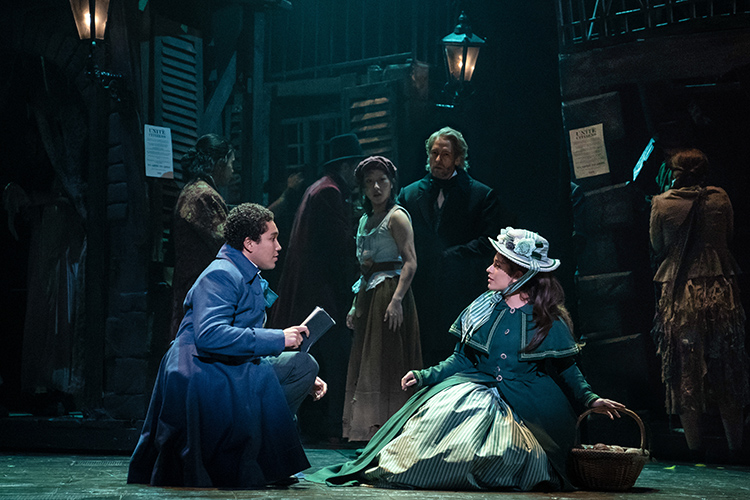
By Sandi Masori

SAN DIEGO — Wow! Phenomenal! Amazing! The most cinematic stage sets I have ever seen! This was basically the conversation in the car on the way home from Les Miserables currently being presented by Broadway in San Diego.
The acting was superb and I’ll come back to that, but I really have to talk about the sets. I have never in my life seen such elaborate and I know I said it above, but cinematic sets. The way that the stage and sets were built, the lighting effects, and the scenes staged to keep most of the action towards the back of the stage, the effect was almost more like watching a movie than a play.
Set designer Matt Kinley used projections, elaborate stage architecture, and ornate props to bring the scenes to life and the effect was simply astounding. Truly my words don’t do it justice and even if the rest of the show were mediocre (which it was not) it would be worth the cost of the tickets to see the sets.
I asked some of the theater staff how many trucks were needed to load in for the show. The answer was around 11 large trucks. That’s about double the average show, and is one of the larger productions the Civic Theatre has housed.
For those who like me have never seen the show before, it’s an English-language opera set in revolutionary France, and is as much a story of love, redemption, friendship, and sorrow as it is about the revolution. It starts with Jean Valjean (Nick Cartell) escaping from a prison chain gang, and after a priest shows him a huge kindness he is moved to help the downtrodden wherever he encounters them. In this spirit he ends up adopting a little girl named Cosette (young Cosette played by Olivia O’ Sullivan and adult Cosette by Addie Morales) after her mother dies in his presence. He becomes very wealthy, perhaps because of the help from the kindly priest, and sets Cosette up for a sheltered life, even as he is harboring the secret of his fugitive status and trying to keep one step ahead of inspector Javert (Preston Truman Boyd) who has made it his life’s mission to catch him.
Lead actor Cartell returned to the stage in the role as Jean Valjean. Later this month he will celebrate a major milestone of his 1000th performance in the role. And that kind of familiarity with the role shone through his performance- it was like watching Topol as Tevya- you really felt that he was the role. There was not a moment where you were aware of the actor instead of the character.
As Broadway’s sixth longest running show, the company has really had time to internalize these characters and it shows. It’s hard to pick standouts because they were all so good. Really really good. The kids have to be called out though because these young performers more than held their own with the seasoned veterans. Young Henry Kirk did an incredible job as Gavroche. O’Sullivan’s young Cosette deserves recognition as well. Phoenix Best was compelling as the lovelorn adult Eponine, with one of the most “realistic” death scenes I’ve seen. Christopher James Tomayo was appropriately annoying as charlatan Montparnasse Thernardier.
Speaking of Thernardier, he has one of the last songs in the show, called A Begger At The Feast.” In this song he’s making fun of the people at the upscale wedding. And it was there, just when I had resigned myself to the idea that there was no clear Jewish angle, that it came. The second stanza of the song is: “here comes a prince, here comes a Jew, here comes a queer, what can you do?”
My companion didn’t notice the line, but my ears are trained for the slightest mention of our people so it jumped out at me. Once again I’m left feeling a little uneasy with the mention. I know that antisemitism was (and is) rampant in France, especially during the revolutionary period, but I can’t help but feel that other than rhyming with “do” it added nothing to the song, and certainly did nothing for our people. Was it necessary? I don’t know.
Besides that little distraction, the show which plays at the Civic Theatre downtown through October 15, is a must see.
*
Sandi Masori is a food and theatre reviewer for San Diego Jewish World. When she’s not covering food or theatre, she helps authors self-publish, hangs out with her kids, and searches for the best sushi in town.